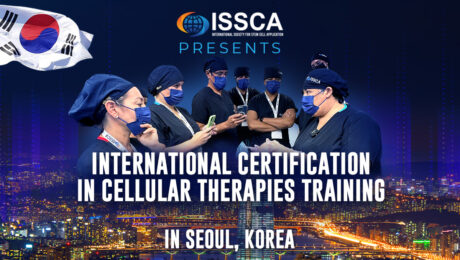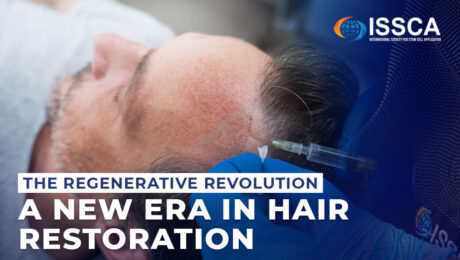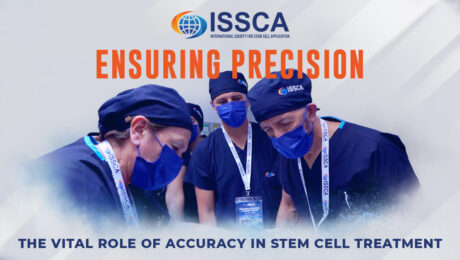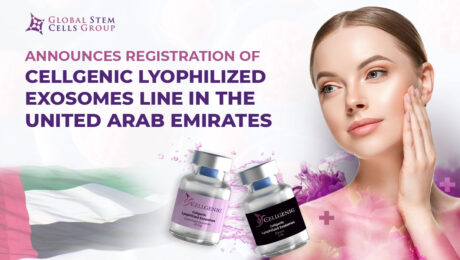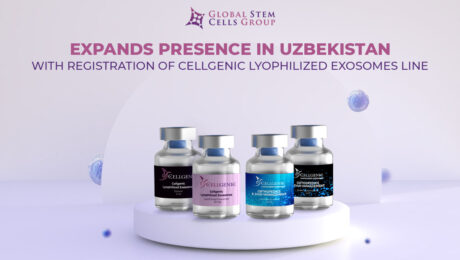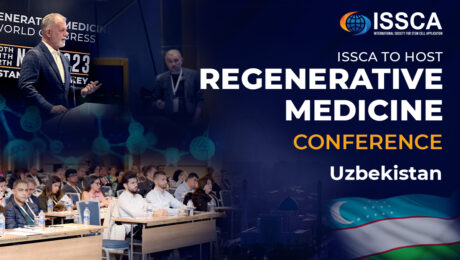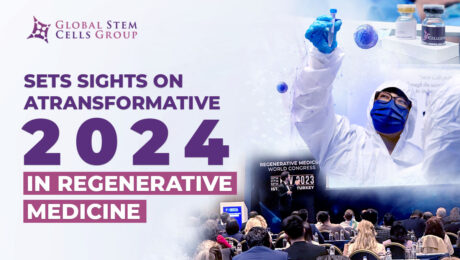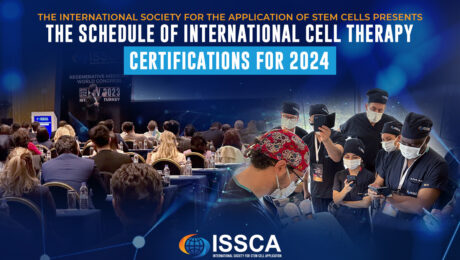International Society for Stem Cell Application Presents International Certification in Cellular Therapies Training in Seoul, Korea
The International Society for Stem Cell Application (ISSCA) proudly announces the upcoming International Certification in Cellular Therapies Training, scheduled to be held in Seoul, Korea, from May 3rd to May 5th, 2024. Sponsored by Global Stem Cells Group, N-BIOTEK Group, Yonsei IMI Stem Clinic, and Regen IC, this training program stands as a pivotal event in the realm of regenerative medicine education.
Commencing on May 3rd with the theoretical component, the training will seamlessly transition into two days of immersive hands-on sessions on May 4th and May 5th at the Yonsei IMI Stem Clinic’s Stem Cell Center. Under the overarching theme of advancing regenerative medicine, the certification training will encompass a broad spectrum of topics, including bone marrow stem cell training and adipose-derived stem cell training, featuring live demonstration therapies and interactive practices. A notable feature of the event includes a Certificate of Completion Ceremony, acknowledging the accomplishments of participants.
Esteemed physicians and researchers will lead panel discussions, delving into the latest advancements in regenerative medicine. Key topics to be explored encompass molecular biology, treatment modalities in surgical and cosmetic applications, and groundbreaking technological innovations propelling the field forward.
A significant highlight of the certification training will be the unveiling of cutting-edge technologies in regenerative medicine and cellular therapies. Attendees will have the unique opportunity to witness live demonstrations of Cellgenic bone marrow kits, which have showcased remarkable efficacy in augmenting stem and progenitor cell concentrations in bone marrow aspiration compared to conventional needles. Overcoming limitations associated with traditional needles, such as restricted flow and impurities in aspirated marrow, these kits represent a monumental leap forward in the field.
Benito Novas, founder of Global Stem Cells Group and Head of Public Relations of ISSCA, expressed, “Through this training and hands-on demonstrations, we aim to further propel the field towards new frontiers of innovation and clinical application.”
Dr. Daeyong Kim, former President, stated, “I am pleased to host this training in Korea, facilitating opportunities for local physicians to advance their expertise in regenerative medicine, thus expanding access to its benefits for our community.”
Dr. Salih Yildirim, the new President, conveyed his enthusiasm, saying, “It is with great pleasure that I return to Korea. Presently, we are organizing several exceptional events, with Korea being a prominent destination among them. We anticipate announcing further initiatives in the near future.”
About ISSCA:
The International Society for Stem Cell Application (ISSCA) is a global network of regenerative medicine practitioners dedicated to advancing the field of stem cell therapy through education, research, and advocacy. With chapters spanning across the globe, ISSCA serves as a platform for collaboration and knowledge exchange among professionals in the regenerative medicine community.
About Global Stem Cells Group:
The Global Stem Cell Group is a family of several companies focused on stem cell medicine and research. The company uses its network to bring leadership in regenerative medicine training, research, and patient applications.
GSCG’s mission is to allow physicians to present the benefits of stem cell medicine to patients worldwide. The company also partners with policymakers, educators, and regulators to promote regenerative medicine.
Global Stem Cells Group is a publicly traded company operating under the symbol MSSV. https://finance.yahoo.com/quote/mssv/
To learn more about Global Stem Cells Group, Inc.’s companies visit our website www.stemcellsgroup.com or call +1 305 560 5331
Safe Harbor Statement:
Statements in this news release may be “forward-looking statements”. Forward-looking statements include, but are not limited to, statements that express our intentions, beliefs, expectations, strategies, predictions, or any other information relating to our future activities or other future events or conditions. These statements are based on current expectations, estimates, and projections about our business based partly on assumptions made by management. These statements are not guarantees of future performance and involve risks, uncertainties, and assumptions that are difficult to predict. Therefore, actual outcomes and results may and are likely to differ materially from what is expressed or forecasted in forward-looking statements due to numerous factors. Any forward-looking statements speak only as of the date of this news release, and The Global Stem Cells Group undertakes no obligation to update any forward-looking statement to reflect events or circumstances after the date of this news release. This press release does not constitute a public offer of any securities for sale. Any securities offered privately will not be or have not been registered under the Act and may not be offered or sold in the United States absent registration or an applicable exemption from registration requirements.
- Published in News
ISSCA Announces Specialized Certification in Advanced Bio-Stimulation IncludingExosomes, Autologous Fibroblasts, Autologous and Allogeneic Stem Cells in Cancun,Mexico
Miami, Florida – The International Society for Stem Cell Application (ISSCA), a
distinguished division of the Global Stem Cells Group (GSCG), is pleased to unveil a
groundbreaking specialized certification program in Advanced Bio-Stimulation,
encompassing Exosomes, Autologous Fibroblasts, Autologous, and Allogeneic Stem
Cells. The program is scheduled to take place in the beautiful city of Cancun, Mexico, on
May 10th and 11th, 2024, featuring a comprehensive theoretical session on the first day
and hands-on practical training on the second day.
Joining the esteemed faculty is Dr. Andrea Lapeire, a renowned Argentine doctor with
extensive expertise in regenerative medicine and aesthetics. With over eight years of
dedicated service within the ISSCA organization, Dr. Lapeire has been instrumental in
enriching our symposiums and serving as an instructor in certification courses held in
Cancun and Buenos Aires. Dr. Lapeire will spearhead this new program focusing on
autologous fibroblasts and advanced bio-stimulation.
The Advanced Bio-Stimulation program will delve into a myriad of essential topics,
equipping participants with a profound understanding of the latest advancements in
regenerative medicine. Some key areas of focus include:
● Regenerative, Reversive, and Preventive Aesthetic Combination
● Theories of Aging
● Cutaneous Modifications in Aging
● Preventive and Reversive Tools: Differentiation
● Regenerative Therapies and their Importance in Health and Aesthetics
● Definition of Bio-Stimulation
● Mechanical, Physical, and Chemical Bio-Stimulants
● Next Generation of Biological Bio-Stimulants
● Collagenesis
● Local and Systemic Fibroblastic Stimulants
● Physical Stimulants: Various Esthetically Significant Technologies
● Photobiomodulation
● Mechanical Stimulants: Biopuncture, Homeosineathria
● PDO Threads: Fundamentals, Bio-Stimulating Techniques, Combined Technique
Management
● Protocols: Facial and Body● Chemical Stimulants: Skin Booster, Mesotherapy, Next Generation
● Slow-Release Hyaluronic Acid: Combination with Bio-Peptides and Amino Acids
● Biological Stimulants: Homeopathized, Peptides, PRP, and Growth Factors
● Regenerative Effect Stimulants: Exosomes, Autologous Fibroblasts, Autologous
and Allogeneic Stem Cells in Anti-Aging and Pro-Youth Applications
● Technique Differences, Expectations from Each, Choosing the Ideal for Each
Patient, Combining for Result Synergy
● Systemic Stimulants: Orthomolecular, Serum Therapy, Micronutrition,
Homeopathized
The theoretical segment of the program will occur on May 10th, providing participants
with a robust knowledge foundation to leverage during the practical sessions. The
hands-on training will be conducted at the prestigious Cellular Hope Institute facility on
May 11th, enabling participants to apply their theoretical insights in a clinical setting
under the guidance of seasoned instructors.
Benito Novas, Founder of Global Stem Cells Group and Head of Public Relations for the
International Society for Stem Cell Application, expressed his enthusiasm, stating, “We
are thrilled to introduce this innovative course at ISSCA. We are committed to remaining
at the vanguard of medical advancements, offering unparalleled education and training
in regenerative medicine and cell therapies to enable professionals to deliver the utmost
quality care to their patients.”
Participation in these specialized programs is expected to give medical professionals
access to cutting-edge research, technological innovations, and clinical protocols,
ensuring they are aptly equipped to meet the evolving demands of the regenerative
medicine industry. Additionally, ISSCA’s Specializations in Regenerative Medicine and
Cell Therapies provide practitioners with an avenue to elevate their clinical practice and
enhance patient outcomes through advanced, evidence-based therapies.
For registration and further information, please contact:
Email: info@stemcellsgroup.com
Phone: +1305 560 5337
About ISSCA:
The International Society for Stem Cell Application (ISSCA) is a multidisciplinary
community of scientists and physicians who aspire to treat diseases and lessen human
suffering through advances in science, technology, and the practice of regenerative
medicine. ISSCA serves its members through advancements made in the specialty of
regenerative medicine.
The mission of ISSCA is to establish itself as a global leader in regenerative medicine
certification, education, research, and training.
ISSCA provides certification training in cities worldwide because it recognizes the
importance of standards and certifications in regenerative medicine as a medical
specialty. To help more people, both locally and globally, as the demand for more
doctors interested in and comfortable with regenerative medicine surges. ISSCA’s
mission is to advance quality and uniformity in regenerative medicine worldwide.
About Global Stem Cells Group:
The Global Stem Cell Group is a family of several companies focused on stem cell
medicine and research. The company uses its network to bring leadership in
regenerative medicine training, research, and patient applications.
GSCG’s mission is to allow physicians to present the benefits of stem cell medicine to
patients worldwide. The company also partners with policymakers, educators, and
regulators to promote regenerative medicine.
Global Stem Cells Group is a publicly traded company operating under the symbol
MSSV. https://finance.yahoo.com/quote/mssv/
To learn more about Global Stem Cells Group, Inc.’s companies visit our website
www.stemcellsgroup.com or call +1 305 560 5331
Safe Harbor Statement:
Statements in this news release may be “forward-looking statements”. Forward-looking
statements include, but are not limited to, statements that express our intentions,
beliefs, expectations, strategies, predictions, or any other information relating to our
future activities or other future events or conditions. These statements are based on
current expectations, estimates, and projections about our business based partly on
assumptions made by management. These statements are not guarantees of future
performance and involve risks, uncertainties, and assumptions that are difficult to
predict. Therefore, actual outcomes and results may and are likely to differ materially
from what is expressed or forecasted in forward-looking statements due to numerous
factors. Any forward-looking statements speak only as of the date of this news release,
and The Global Stem Cells Group undertakes no obligation to update any forward-
looking statement to reflect events or circumstances after the date of this news release.
This press release does not constitute a public offer of any securities for sale. Any
securities offered privately will not be or have not been registered under the Act and
may not be offered or sold in the United States absent registration or an applicable
exemption from registration requirements.
- Published in News
The Regenerative Revolution: A New Era in Hair Restoration
The Pursuit of Luscious Locks: Evolution of Hair Restoration
Traditional Hair Transplants: The Old Guard
For decades, methods like Follicular Unit Transplantation (FUT) and Follicular Unit Extraction (FUE) have dominated hair restoration, moving hair follicles from donor areas to balding spots. However, these methods often leave scars and have limited donor hair availability.
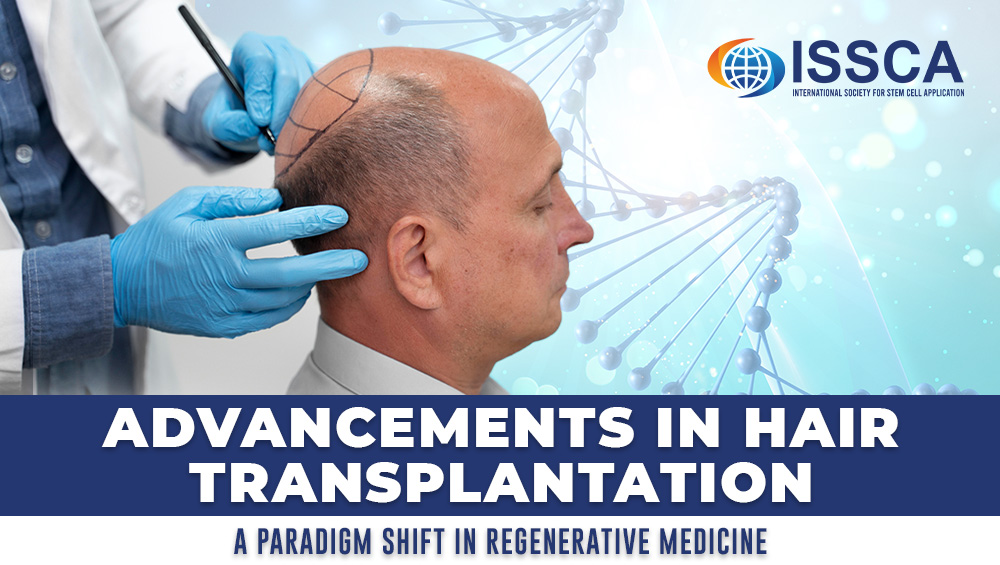
Regenerative Medicine: Revolutionizing Hair Restoration
Regenerative medicine is reshaping hair restoration with innovative approaches:
Stem Cell Therapy: Stem cells can differentiate into hair follicles, potentially stimulating hair regeneration and natural growth when introduced into the scalp.
Platelet-Rich Plasma (PRP): Using the patient’s blood enriched with growth factors, PRP therapy revitalizes hair follicles, promoting improved hair growth and quality.
Exosomes: These cellular vesicles aid in hair growth by reducing inflammation and supporting tissue regeneration, creating an optimal environment for follicle health.
Why This Transformation Matters
The shift to regenerative medicine in hair restoration goes beyond aesthetics:
Scar Minimization: Regenerative techniques minimize scarring, leading to more aesthetically pleasing results.
Enhanced Outcomes: Patients often experience more natural, robust hair growth compared to traditional methods.
Personalized Care: Regenerative medicine allows for tailored treatments that address each patient’s specific needs and hair restoration goals.
The Future of Hair Restoration
Hair transplants are undergoing a revolution with regenerative medicine:
The integration of regenerative techniques promises more natural, minimally invasive, and personalized solutions for hair loss.
Embrace the Future of Hair Restoration
Explore the frontier of regenerative medicine in hair restoration with ISSCA. Discover cutting-edge courses and insights shaping the future of healthcare on our website.
- Published in Blog
Ensuring Precision: The Vital Role of Accuracy in Stem Cell Treatment
In the realm of regenerative medicine, precision is paramount. Stem cell treatments hold immense promise for addressing a myriad of health conditions, but their effectiveness hinges on accuracy at every stage of the process. Let’s delve into why precision matters and how it shapes the landscape of stem cell therapy.
Understanding the Importance of Accuracy:
- Targeting Specific Cells: Stem cell treatments involve delivering therapeutic cells to precise locations within the body. Whether it’s repairing damaged tissues or modulating the immune system, the accuracy of cell placement directly influences treatment outcomes.
- Dosage Precision: Like any medical intervention, stem cell therapy requires precise dosing. Administering the correct number of cells ensures therapeutic efficacy while minimizing the risk of adverse effects. Accuracy in dosage calculation is crucial for achieving optimal results.
- Quality Control: From cell isolation to culture expansion and beyond, maintaining accuracy is essential for preserving the integrity of stem cells. Quality control measures, including rigorous testing and validation protocols, help uphold standards and ensure the safety and potency of cellular products.
- Patient-Specific Treatment: Personalized medicine is increasingly becoming the norm, and stem cell therapy is no exception. Tailoring treatments to individual patients requires meticulous attention to detail and accuracy in assessing each patient’s unique needs and characteristics.
Why Accuracy Matters:
- Enhanced Treatment Efficacy: Precise delivery and dosing of stem cells increase the likelihood of therapeutic success, leading to improved patient outcomes and satisfaction.
- Minimized Risks: Accurate procedures reduce the potential for complications such as immune reactions, tissue rejection, or unintended effects, enhancing the safety profile of stem cell therapies.
- Scientific Advancement: Precision in stem cell research and clinical practice drives innovation and contributes to a deeper understanding of cellular mechanisms, paving the way for future advancements in regenerative medicine.
At ISSCA, we prioritize accuracy in every aspect of stem cell treatment, from education and training to clinical practice. Our certification programs equip healthcare professionals with the knowledge and skills needed to deliver precise and effective stem cell therapies. Join us in advancing the field of regenerative medicine and ensuring the highest standards of accuracy and excellence.
For more information about our certifications, conferences, and educational resources, visit our website today. Take the next step in your journey toward mastering stem cell treatment with ISSCA.
- Published in News
Global Stem Cells Group (GSCG) Announces Registration of Cellgenic Lyophilized Exosomes Line in the United Arab Emirates
Miami, Florida – Global Stem Cells Group (GSCG) is delighted to announce the successful registration of its Cellgenic Lyophilized Exosomes line throughout the entire region of the United Arab Emirates (UAE). This significant achievement marks a pivotal moment for both GSCG and the field of regenerative medicine in the UAE, facilitating greater access to advanced therapeutic options for healthcare professionals and patients alike.
Exosomes, extracellular vesicles secreted by cells, have garnered considerable attention in regenerative medicine due to their ability to carry bioactive molecules that modulate various cellular functions critical for tissue repair and regeneration. The Cellgenic Exosomes, now available to practicing doctors in the United Arab Emirates, represent a cutting-edge advancement in this field.
The registration of Cellgenic Lyophilized Exosomes in the UAE not only empowers healthcare professionals with a powerful therapeutic tool but also streamlines distribution logistics. Unlike traditional exosome products that require stringent refrigeration during transport, the lyophilized formulation can be shipped and stored at ambient temperatures, enhancing accessibility even in regions with challenging infrastructure.
Benito Novas, Founder of the Global Stem Cells Group, expressed his enthusiasm, stating, “With the registration of this groundbreaking exosome product, Global Stem Cells Group reaffirms its commitment to advancing regenerative medicine in the region. We are dedicated to providing healthcare professionals with innovative solutions that can transform patient care and outcomes.”
Dave Christensen, CEO of Global Stem Cells Group, echoed these sentiments, emphasizing the significance of this achievement in expanding the reach of regenerative medicine. “The registration of Cellgenic Lyophilized Exosomes in the UAE represents a significant milestone in our mission to commercialize access to cutting-edge therapies worldwide. We are proud to contribute to the advancement of healthcare in this region and beyond,” he remarked.
Global Stem Cells Group continues to demonstrate rapid growth and innovation, with a global network of offices and a steadfast commitment to driving progress in regenerative medicine. The registration of Cellgenic Lyophilized Exosomes in the UAE further solidifies GSCG’s position as a leader in the field, poised to deliver transformative solutions to patients worldwide.
About Cellgenic
Cellgenic is a distinguished brand renowned for its cellular products and kits featuring the latest advancements in regenerative medicine, including Exosomes, Collagenase, PRP, Wharton’s jelly mesenchymal cells, and more. Committed to excellence in research and development, Cellgenic strives to provide healthcare professionals with cutting-edge technologies of the highest quality to enhance patient care and outcomes.
About Global Stem Cells Group:
The Global Stem Cell Group is a family of several companies focused on stem cell medicine and research. The company uses its network to bring leadership in regenerative medicine training, research, and patient applications.
GSCG’s mission is to allow physicians to present the benefits of stem cell medicine to patients worldwide. The company also partners with policymakers, educators, and regulators to promote regenerative medicine.
Global Stem Cells Group is a publicly traded company operating under the symbol MSSV. https://finance.yahoo.com/quote/mssv/
To learn more about Global Stem Cells Group, Inc.’s companies visit our website www.stemcellsgroup.com or call +1 305 560 5331
Safe Harbor Statement:
Statements in this news release may be “forward-looking statements”. Forward-looking statements include, but are not limited to, statements that express our intentions, beliefs, expectations, strategies, predictions, or any other information relating to our future activities or other future events or conditions. These statements are based on current expectations, estimates, and projections about our business based partly on assumptions made by management. These statements are not guarantees of future performance and involve risks, uncertainties, and assumptions that are difficult to predict. Therefore, actual outcomes and results may and are likely to differ materially from what is expressed or forecasted in forward-looking statements due to numerous factors. Any forward-looking statements speak only as of the date of this news release, and The Global Stem Cells Group undertakes no obligation to update any forward-looking statement to reflect events or circumstances after the date of this news release. This press release does not constitute a public offer of any securities for sale. Any securities offered privately will not be or have not been registered under the Act and may not be offered or sold in the United States absent registration or an applicable exemption from registration requirements
- Published in News
Global Stem Cells Group (GSCG) Expands Presence in Uzbekistan with Registration of Cellgenic Lyophilized Exosomes Line
Miami, Florida– Global Stem Cells Group is pleased to announce the official registration of its Cellgenic Lyophilized Exosomes line throughout the region of Uzbekistan. This significant milestone allows doctors and distributors in Uzbekistan to access and utilize the two Lyophilized Exosomes product lines, specifically tailored for aesthetic and orthopedic applications.
Utilizing cutting-edge exosome technology, the Cellgenic Lyophilized Exosomes involve the freeze-drying of extracellular vesicles (EVs) separately from mesenchymal stem cell cultures expanded in the laboratory. These Lyophilized Exosomes, reconstituted with saline just before use, have proven to be highly effective in reducing inflammation and managing pain.
An outstanding feature of the Lyophilized Exosomes is their global shipping capability without the need for refrigeration. This eliminates logistical challenges related to temperature requirements, ensuring easy access to various locations without constraints. Global Stem Cells Group has prioritized versatility, addressing common limitations faced by many medications.
Uzbekistan will now have access to both presentations of Cellgenic Lyophilized Exosomes. The aesthetic line, primarily utilized by aesthetic doctors and dermatologists, and the orthopedic “the Rege series,” dedicated to pain management and sports medicine. This expansion in product availability underscores Global Stem Cells Group’s commitment to providing innovative solutions that overcome challenges and meet diverse medical needs.
Experiencing Unprecedented Growth
Global Stem Cells Group is on an impressive growth trajectory with multiple offices worldwide. The company is dedicated to expanding its outreach by opening offices wherever it is prudent to do so. The recent product registration in the region is expected to further strengthen GSCG’s position as a global leader in the regenerative and restorative medicine space.
Consolidating Presence in Uzbekistan
GSCG is solidifying its presence in Uzbekistan with the inauguration of a clinic and training center in Tashkent in 2023. Now, in 2024, the company marks the beginning of the year with the registration of its successful product line, Cellgenic Exosomes, promising stability and recognition in Uzbekistan and neighboring countries.
Benito Novas, CEO of Global Stem Cells Group, expressed his enthusiasm for the company’s growth, stating: “Our goal at Global Stem Cells Group is to make available to all doctors and patients the latest technologies in Regenerative Medicine. I am very pleased that Uzbekistan has joined us. Now, we not only have a point to treat patients and train doctors, but they can also benefit from cellgenic exosomes, which are part of the latest technologies revolutionizing the field of regenerative medicine.”
About Cellgenic
Cellgenic is a brand of cellular products and kits equipped with the latest technologies in the regenerative medicine market, including Exosomes, Collagenase, PRP, Wharton’s jelly mesenchymal cells, and more. Constantly engaged in research, Cellgenic aims to provide doctors and patients with the latest technologies of the highest quality.
About Global Stem Cells Group:
The Global Stem Cell Group is a family of several companies focused on stem cell medicine and research. The company uses its network to bring leadership in regenerative medicine training, research, and patient applications.
GSCG’s mission is to allow physicians to present the benefits of stem cell medicine to patients worldwide. The company also partners with policymakers, educators, and regulators to promote regenerative medicine.
Global Stem Cells Group is a publicly traded company operating under the symbol MSSV. https://finance.yahoo.com/quote/mssv/
To learn more about Global Stem Cells Group, Inc.’s companies visit our website www.stemcellsgroup.com or call +1 305 560 5331
Safe Harbor Statement:
Statements in this news release may be “forward-looking statements”. Forward-looking statements include, but are not limited to, statements that express our intentions, beliefs, expectations, strategies, predictions, or any other information relating to our future activities or other future events or conditions. These statements are based on current expectations, estimates, and projections about our business based partly on assumptions made by management. These statements are not guarantees of future performance and involve risks, uncertainties, and assumptions that are difficult to predict. Therefore, actual outcomes and results may and are likely to differ materially from what is expressed or forecasted in forward-looking statements due to numerous factors. Any forward-looking statements speak only as of the date of this news release, and The Global Stem Cells Group undertakes no obligation to update any forward-looking statement to reflect events or circumstances after the date of this news release. This press release does not constitute a public offer of any securities for sale. Any securities offered privately will not be or have not been registered under the Act and may not be offered or sold in the United States absent registration or an applicable exemption from registration requirements.
- Published in News
International Society for Stem Cell Application (ISSCA) to Host Regenerative Medicine Conference in Termez, Uzbekistan
MIAMI, Florida – January 29, 2024 – The International Society for Stem Cell Application (ISSCA), a globally recognized leader in Regenerative Medicine, is delighted to announce its forthcoming regenerative medicine conference in Termez city, Republic of Uzbekistan. The theoretical conference is scheduled to take place on March 4-5, 2024, at the conference hall of the International Research Center Imam Termeziy.
ISSCA has established a strategic partnership with the Ministry of Health of the Republic of Uzbekistan, specifically the Termez branch of Tashkent Medical Academy (Ozbekiston Respublikasi Sogliqni Saqlash Vazirligi), to organize this impactful event. This collaboration exemplifies the shared commitment of ISSCA and the Ministry of Health to advancing healthcare through the dissemination of knowledge in the field of regenerative medicine in the region.
The primary objective of the conference is to bring together experts from diverse backgrounds in regenerative medicine, fostering collaboration between science and practice. Distinguished foreign scientists specializing in regenerative medicine, cell therapy applications in degenerative diseases, transplantation, traumatology, dermatology, neuroimmune diseases, and rehabilitation will be in attendance.
Key Focus Areas of the Conference Program:
A panel of esteemed experts on stem cells and regenerative medicine will feature at the conference. They will conduct a two-day rigorous research-based discussion on the vital topic covering stem cells and regenerative medicine.
World-class medical experts in regenerative medicine will share their skills and experience during the theoretical session. The conference will feature esteemed speakers from Turkey, Uzbekistan, and the USA.
The conference will focus on a wide range of topics, including:
- Regenerative medicine – the need for knowledge in various fields of medicine
- Exosomes/ Extracellular Vesicles
- Mesenchymal stem/stromal cells
- Hematopoietic stem/progenitor cells and engineering
- Gene editing/Gene therapy
- Immunotherapy (CAR-Ts, T Reg, NK cells, etc.)
- Tissue engineering
- Embryonic, organ, and other tissue-specific stem cells
- Application of biomedical cell products in organ and tissue transplantation
- Immunologic aspects of cell therapy for human diseases
- Knowledge in the field of the application of mesenchymal stromal cells in medical practice
What the ISSCA Organization has to say:
Dr. Salih Yildirim, ISSCA president, expressed his eagerness to share his expertise, stating, “Regenerative medicine is a fast-paced field experiencing exponential growth with ongoing research and product advancements worldwide. We are thrilled to collaborate with the Termez branch of Tashkent Medical Academy to host this conference.”
Benito Novas, Founder of Global Stem Cells Group and head of public relations at ISSCA, added, “ISSCA’s mission is to share regenerative medicine’s benefits worldwide, supporting patients and physicians in harnessing its power globally.”
The conference expects to be a unique platform for knowledge exchange, collaboration, and advancements in the field of regenerative medicine. ISSCA invites professionals, researchers, and enthusiasts to join this groundbreaking event in the pursuit of enhancing global healthcare through cutting-edge regenerative medicine practices.
For more information, please visit ISSCA Conference – Tashkent, March 2024.
Final Words About the Conference:
Regenerative medicine is rapidly growing with continuous explorations revealing new protocols and products. The conference aims to keep participants updated with the industry’s most recent changes and advancements, empowering them to explore more opportunities and be part of a valuable stem cell community.
Learn more about ISSCA and advancements in stem cell therapy by visiting our website or emailing us at info@stemcellsgroup.com.
About the Termiz Branch of the Tashkent Medical Academy:
Established in 2018, the Termiz branch of the Tashkent Medical Academy aims to produce highly skilled medical professionals meeting global standards. Committed to academic excellence, the branch offers opportunities for teachers to obtain scientific degrees through research, conducting doctoral dissertations, and anticipates a progressive increase in research activities, solidifying its role in shaping Uzbekistan’s healthcare future.
About ISSCA:
The International Society for Stem Cell Application (ISSCA) is a multidisciplinary community of scientists and physicians who aspire to treat diseases and lessen human suffering through advances in science, technology, and the practice of regenerative medicine. ISSCA serves its members through advancements made in the specialty of regenerative medicine.
The mission of ISSCA is to establish itself as a global leader in regenerative medicine certification, education, research, and training.
ISSCA provides certification training in cities worldwide because it recognizes the importance of standards and certifications in regenerative medicine as a medical specialty. To help more people, both locally and globally, as the demand for more doctors interested in and comfortable with regenerative medicine surges. ISSCA’s mission is to advance quality and uniformity in regenerative medicine worldwide.
About Global Stem Cells Group:
The Global Stem Cell Group is a family of several companies focused on stem cell medicine and research. The company uses its network to bring leadership in regenerative medicine training, research, and patient applications.
GSCG’s mission is to allow physicians to present the benefits of stem cell medicine to patients worldwide. The company also partners with policymakers, educators, and regulators to promote regenerative medicine.
Global Stem Cells Group is a publicly traded company operating under the symbol MSSV. https://finance.yahoo.com/quote/mssv/
To learn more about Global Stem Cells Group, Inc.’s companies visit our website www.stemcellsgroup.com or call +1 305 560 5331
Safe Harbor Statement:
Statements in this news release may be “forward-looking statements”. Forward-looking statements include, but are not limited to, statements that express our intentions, beliefs, expectations, strategies, predictions, or any other information relating to our future activities or other future events or conditions. These statements are based on current expectations, estimates, and projections about our business based partly on assumptions made by management. These statements are not guarantees of future performance and involve risks, uncertainties, and assumptions that are difficult to predict. Therefore, actual outcomes and results may and are likely to differ materially from what is expressed or forecasted in forward-looking statements due to numerous factors. Any forward-looking statements speak only as of the date of this news release, and The Global Stem Cells Group undertakes no obligation to update any forward-looking statement to reflect events or circumstances after the date of this news release. This press release does not constitute a public offer of any securities for sale. Any securities offered privately will not be or have not been registered under th
- Published in News
Global Stem Cells Group (GSCG) Sets Sights on a Transformative 2024 in Regenerative Medicine
Miami, Florida [01/22/2024] – Global Stem Cells Group, a pioneer in the regenerative medicine sector, has outlined its strategic projections for the year 2024. The company, committed to advancing stem cell research, patient treatments, and physician education, aims to generate over $4 million in top-line revenue through a multifaceted approach within the rapidly expanding stem cell therapy market.
Global Stem Cells Group’s comprehensive strategy encompasses key areas such as certified training courses for physicians, manufacturing and sales of the newest technology, supplies, and equipment, research and development of clinical protocols, regenerative medicine clinics for patient treatments, membership network of regenerative medicine practitioners, and turnkey solutions for stem cell processing center installation and management.
Market Overview
The regenerative medicine market, poised to reach USD 90.13 Billion by 2030, is witnessing unprecedented growth. Recognizing the vast potential of regenerative medicine, Global Stem Cells Group aims to play a pivotal role in shaping the dynamic landscape of this industry.
Business Strategy in 2024:
Certified Training Courses for Physicians
Global Stem Cells Group’s educational arm, the International Society for Stem Cells Application (ISSCA), is set to conduct 2 courses every month at various affiliated centers worldwide. These courses aim not only to disseminate cutting-edge knowledge but also to establish new industry standards, enhancing the quality and rigor of training in regenerative medicine.
Milestones and goals for 2024 include global expansion, hosting 3 international congresses, introducing advanced courses on cutting-edge technologies, and establishing permanent courses and workshops at ReGen Networks Clinics.
Manufacturing and Sales of Newest Technology, Supplies, and Equipment
In the sale of cellular therapy products and technologies, Global Stem Cells Group plans to boost global sales by establishing validation departments, integrating new technologies into the Cellgenic product line, and establishing distribution centers in various countries. The goal is to position the company at the forefront of the evolving field of regenerative medicine.
Research and Development of Clinical Protocols
Global Stem Cells Group is committed to pioneering new frontiers in regenerative medicine by developing cutting-edge treatment protocols. The incorporation of innovative technologies reflects the company’s dedication to providing patients and physicians with advanced therapeutic options.
Regenerative Medicine Clinics (Patient Treatment)
Expansion plans in 2024 include the opening of two new treatment centers alongside the continued growth of the existing center in Cancun. These centers are expected to serve as training centers for physicians, research and development hubs, and contribute to top-line revenue through treatment services, physician training programs, research collaborations, and product development.
Membership Network of Regenerative Medicine Practitioners
Global Stem Cells Group aims to expand its ReGen network by opening four new regenerative medicine centers across the globe. The ReGen membership program offers a comprehensive turnkey solution for individuals interested in establishing their own regenerative medicine clinic, contributing to revenue growth.
Turnkey Solutions for Stem Cell Processing Center Installation & Management
In 2024, Global Stem Cells Group envisions a pioneering role in the field of personalized stem cell laboratories, offering bespoke projects tailored to clients’ unique needs and setting new benchmarks in regenerative medicine.
Market Positioning and Recognition
The strategic expansion into these key areas positions Global Stem Cells Group as a global leader in regenerative medicine. The company’s commitment to education, product sales, research, patient services, and strategic partnerships within the stem cell therapy market sets the stage for transformative achievements in 2024.
Through these strategic initiatives, Global Stem Cells Group aims to not only contribute to the continuous advancement of regenerative medicine but also to position itself as a global leader in the industry.
The company invites healthcare professionals, researchers, and stakeholders to join them on this transformative journey as they redefine the future of medical innovation and elevate the standards of regenerative medicine in 2024.
About Global Stem Cells Group:
The Global Stem Cell Group is a family of several companies focused on stem cell medicine and research. The company uses its network to bring leadership in regenerative medicine training, research, and patient applications.
GSCG’s mission is to allow physicians to present the benefits of stem cell medicine to patients worldwide. The company also partners with policymakers, educators, and regulators to promote regenerative medicine.
Global Stem Cells Group is a publicly traded company operating under the symbol MSSV. https://finance.yahoo.com/quote/mssv/
To learn more about Global Stem Cells Group, Inc.’s companies visit our website www.stemcellsgroup.com or call +1 305 560 5331.
Safe Harbor Statement: Statements in this news release may be “forward-looking statements”. Forward-looking statements include, but are not limited to, statements that express our intentions, beliefs, expectations, strategies, predictions, or any other information relating to our future activities or other future events or conditions. These statements are based on current expectations, estimates, and projections about our business based partly on assumptions made by management. These statements are not guarantees of future performance and involve risks, uncertainties, and assumptions that are difficult to predict. Therefore, actual outcomes and results may and are likely to differ materially from what is expressed or forecasted in forward-looking statements due to numerous factors. Any forward-looking statements speak only as of the date of this news release, and The Global Stem Cells Group undertakes no obligation to update any forward-looking statement to reflect events or circumstances after the date of this news release. This press release does not constitute a public offer of any securities for sale. Any securities offered privately will not be or have not been registered under the Act and may not be offered or sold in the United States absent registration or an applicable exemption from registration requirements.
- Published in News
International Society for Stem Cell Application (ISSCA) Announces InternationalSymposium on Regenerative Medicine and Cellular Therapies in Cancún, México
Miami, Florida – The International Society for Stem Cell Application (ISSCA), a distinguished division of the Global Stem Cells Group (GSCG), is delighted to unveil its much-anticipated international symposium on Regenerative Medicine and Cellular Therapies. This groundbreaking event is set to take place in the vibrant city of Cancún, México, over three days, from June 14th to 16th, 2024, with one day dedicated to conferences and the subsequent two days featuring hands-on sessions.
A Global Gathering of Scientific Minds
The symposium aims to bring together leading scientists and medical professionals from around the world, providing an unparalleled platform to explore and discuss the latest advancements in regenerative medicine. With elite speakers, including renowned scientists and physicians with extensive experience in the field, attendees are expected to gain unique insights into the cutting-edge clinical applications of stem cell therapies.
Key Highlights of the Symposium
- Stay Ahead with the Latest Technologies:
Attendees will be at the forefront of breakthrough technologies in regenerative medicine. Learn about the most recent advancements that are reshaping the landscape of healthcare and discover how these technologies may elevate your practice and patient care.
- Explore Cutting-Edge Products and Equipment:
Gain firsthand insights into the latest products and equipment driving the field of stem cell therapy. From state-of-the-art medical devices to groundbreaking tools, discover innovations that may enhance your clinical practice and contribute to better patient outcomes.
- Delve into Tissue Engineering:
Tissue engineering is a frontier where science meets medical marvels. Attendees will have the opportunity to delve into the intricacies of tissue engineering, understanding how it is revolutionizing regenerative medicine and paving the way for transformative treatments.
- Comprehensive Understanding of Regenerative Medicine:
Broaden your understanding of regenerative medicine as a whole. From foundational principles to cutting-edge applications, the symposium provides a comprehensive overview, equipping attendees with the knowledge needed to excel in this rapidly evolving field.
- Network with Industry Leaders and Peers:
Connect with a diverse and dynamic community of professionals, including doctors, researchers, innovators, and decision-makers. Engage in meaningful conversations, forge collaborations, and build a network that extends beyond the symposium, providing ongoing support and insights.
- Acquire Practical Knowledge from Hands-On Training:
Beyond theoretical insights, the symposium offers invaluable hands-on training sessions led by ISSCA-certified instructors. Gain practical experience in the aesthetic and clinical applications of stem cell therapy, ensuring you leave with skills ready for immediate implementation.
- Navigate Regulatory:
Stay informed on the latest regulatory and ethical considerations in stem cell technology. Navigate the complexities of compliance while gaining insights into how to address challenges in a rapidly evolving regulatory landscape.
- Stay Informed on Marketing Trends:
Learn about modern technologies that can enhance your marketing efforts in the field of regenerative medicine. Stay ahead of the curve with insights into effective strategies to promote your practice and reach a wider audience.
In short, the ISSCA International Symposium is not just an event; it is an immersive experience that seeks to empower attendees with the knowledge, skills and connections needed to shape the future of regenerative medicine. Join us in Cancun, Mexico, and be a catalyst for positive change in the medical landscape.
For registration and additional information, please contact:
Email: info@stemcellsgroup.com
Phone: +1305 560 5337
About ISSCA:
The International Society for Stem Cell Application (ISSCA) is a multidisciplinary community of scientists and physicians who aspire to treat diseases and lessen human suffering through advances in science, technology, and the practice of regenerative medicine. ISSCA serves its members through advancements made in the specialty of regenerative medicine.
The mission of ISSCA is to establish itself as a global leader in regenerative medicine certification, education, research, and training.
ISSCA provides certification training in cities worldwide because it recognizes the importance of standards and certifications in regenerative medicine as a medical specialty. To help more people, both locally and globally, as the demand for more doctors interested in and comfortable with regenerative medicine surges. ISSCA’s mission is to advance quality and uniformity in regenerative medicine worldwide.
About Global Stem Cells Group:
The Global Stem Cell Group is a family of several companies focused on stem cell medicine and research. The company uses its network to bring leadership in regenerative medicine training, research, and patient applications.
GSCG’s mission is to allow physicians to present the benefits of stem cell medicine to patients worldwide. The company also partners with policymakers, educators, and regulators to promote regenerative medicine.
Global Stem Cells Group is a publicly traded company operating under the symbol MSSV. https://finance.yahoo.com/quote/mssv/
To learn more about Global Stem Cells Group, Inc.’s companies visit our website www.stemcellsgroup.com or call +1 305 560 5331
Safe Harbor Statement:
Statements in this news release may be “forward-looking statements”. Forward-looking statements include, but are not limited to, statements that express our intentions, beliefs, expectations, strategies, predictions, or any other information relating to our future activities or other future events or conditions. These statements are based on current expectations, estimates, and projections about our business based partly on assumptions made by management. These statements are not guarantees of future performance and involve risks, uncertainties, and assumptions that are difficult to predict. Therefore, actual outcomes and results may and are likely to differ materially from what is expressed or forecasted in forward-looking statements due to numerous factors. Any forward-looking statements speak only as of the date of this news release, and The Global Stem Cells Group undertakes no obligation to update any forward-looking statement to reflect events or circumstances after the date of this news release. This press release does not constitute a public offer of any securities for sale. Any securities offered privately will not be or have not been registered under the Act and may not be offered or sold in the United States absent registration or an applicable exemption from registration requirements.
- Published in News
The International Society for the Application of Stem Cells presents the schedule of International Cellular therapy certifications for 2024.
The International Society for the Application of Stem Cells presents the schedule of International Cellular therapy certifications for 2024.
Miami, Florida – ISSCA, the International Society for Stem Cell Application and the Educational Division of Global Stem Cells Group, a global leader in cellular therapies and regenerative medicine education, proudly unveils its 2024 schedule for upcoming training dates in multiple countries. In alignment with ISSCA’s mission to extend the benefits of regenerative medicine to all, the organization invites the participation of physicians interested in advancing their expertise in the field.
ISSCA’s commitment to advancing regenerative medicine is exemplified by providing participants with exclusive access to the latest cutting-edge technologies in biologics and regenerative medicine products.
Participants are expected to learn valuable insights into the practical applications of these technologies and acquire knowledge on how regenerative medicine can contribute to addressing contemporary medical challenges, ultimately enhancing patient care.
ISSCA’s comprehensive training program comprises a one-day theoretical segment in which participants learn the fundamentals of cell therapies. It includes discussions on relevant cases and technologies. The practical part encourages participants to apply these therapies on real patients, a portion that lasts from one to two days depending on the ISSCA educational program in the country of the training. Technologies covered include exosomes, umbilical cord stem cells (where permitted), bone marrow and fat stem cells, PRP, and various alternative therapies.
These certifications are meticulously designed for physicians and specialists seeking to expand their knowledge of regenerative medicine and integrate diverse cell therapies into their medical practices.
Key Training Dates for 2024:
- Cancun, Mexico: February 9, 10, and 11
- Istanbul, Turkey: February 23 and 24
- Buenos Aires, Argentina: March 8 & 9
- Cancun, Mexico: March 22, 23, and 24
- Brussels, Belgium: March 29 and 30
- Cancun, Mexico: April 5, 6, and 7
- Lisbon, Portugal: April 12 and 13
- Fort Lauderdale, USA: April 19 and 20
- Santo Domingo, Dominican Republic: May 3 & 4
- Dubai, UAE: May 17-18
- Istanbul, Turkey: May 24-25
- Cancun, Mexico: June 14, 15, and 16
- Buenos Aires, Argentina: June 28-29
- Istanbul, Turkey: July 5 and 6
- Cancun, Mexico: August 9-10-11
For more information on ISSCA certifications and to make reservations, visit https://www.issca.us/, email info@stemcellsgroup.com, or call +1305 560 5337.
About ISSCA:
ISSCA is the educational division of Global Stem Cells Group, serving as a multidisciplinary community of scientists and physicians aspiring to treat disease and diminish human suffering through advances in the science, technology, and practice of regenerative medicine. ISSCA serves its members through advances made in the specialty of regenerative medicine.
ISSCA offers certification training in cities around the world, recognizing the importance of standards and certifications in regenerative medicine as a medical specialty. The mission is to promote quality and consistency in regenerative medicine worldwide.
About Global Stem Cells Group:
Global Stem Cell Group is a family of several companies focused on stem cell medicine and research. The company utilizes its network to provide leadership in regenerative medicine education, research, and patient applications.
GSCG’s mission is to enable physicians to present the benefits of stem cell medicine to patients worldwide. The company also collaborates with policymakers, educators, and regulators to promote regenerative medicine.
Global Stem Cells Group is a publicly traded company under the symbol MSSV. https://finance.yahoo.com/quote/mssv/.
For more information about Global Stem Cells Group, Inc. companies, visit our website www.stemcellsgroup.com or call +1 305 560 5331.
Safe Harbor Statement:
Statements in this news release may be “forward-looking statements.” Forward-looking statements include, but are not limited to, statements that express our intentions, beliefs, expectations, strategies, predictions, or any other information relating to our future activities or other future events or conditions. These statements are based on current expectations, estimates, and projections about our business based partly on assumptions made by management. These statements are not guarantees of future performance and involve risks, uncertainties, and assumptions that are difficult to predict. Therefore, actual outcomes and results may and are likely to differ materially from what is expressed or forecasted in forward-looking statements due to numerous factors. Any forward-looking statements speak only as of the date of this news release, and The Global Stem Cells Group undertakes no obligation to update any forward-looking statement to reflect events or circumstances after the date of this news release. This press release does not constitute a public offer of any securities for sale. Any securities offered privately will not be or have not been registered under the Act and may not be offered or sold in the United States absent registration or an applicable exemption from registration requirements.
- Published in News

